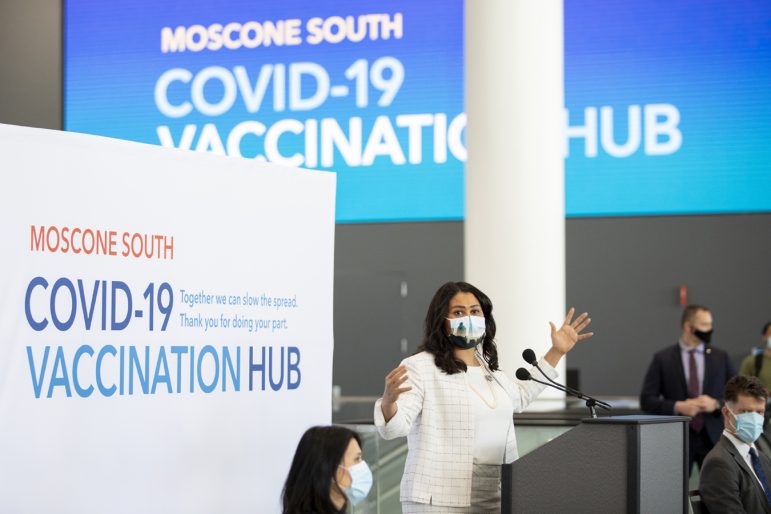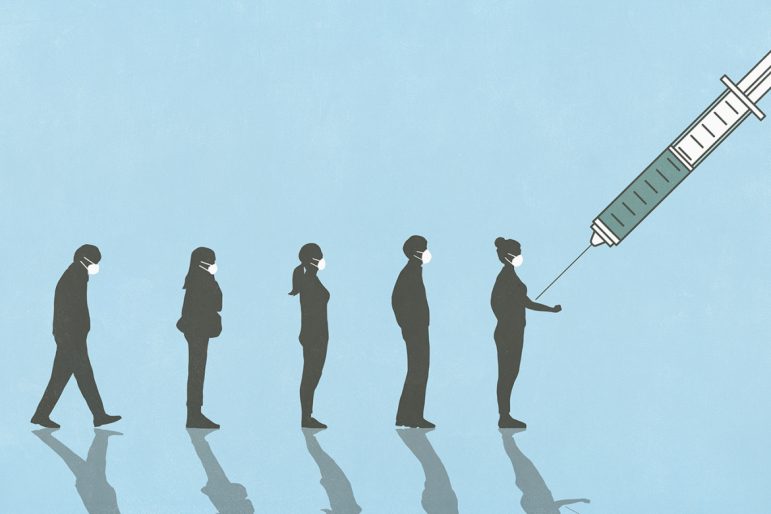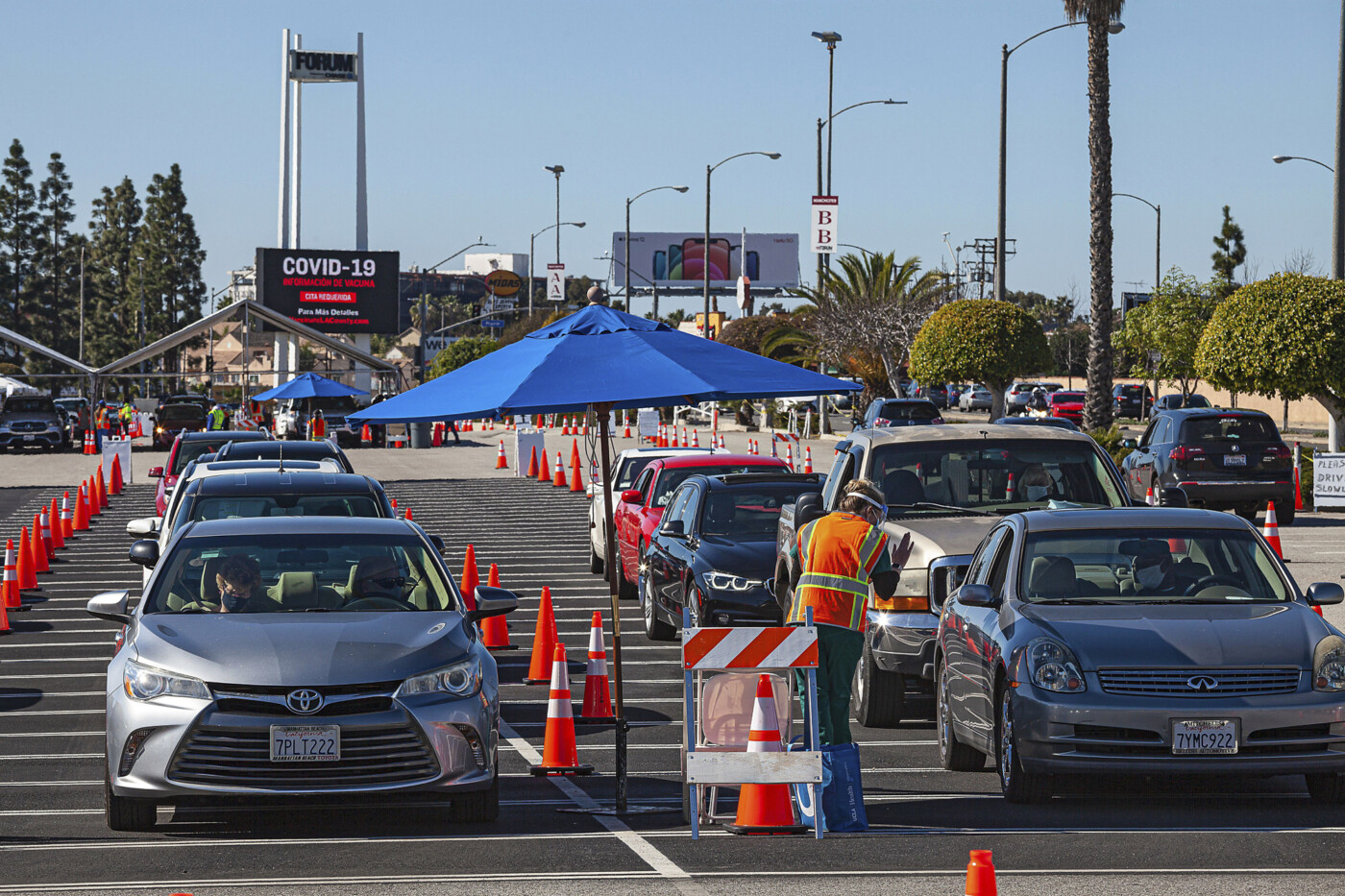Sascha Hughes-Caley was a little uncertain as she registered with a state website promising to connect volunteers with COVID-19 vaccination clinics that needed help. She had time to volunteer after being laid off from her educational technology job, but she was still caring for her toddler and wasn’t sure she could handle a long shift.
Hughes-Caley heard nothing about volunteer opportunities for several weeks, then she was referred to a Santa Clara County organization and asked to fill out paperwork.
“There were never any clear instructions on what I was supposed to do, who I was supposed to contact,” said Hughes-Caley, 36, of San Jose. “I felt like it was not worth it.”
So she gave up.
When state officials launched their MyTurn Volunteer website in early March, they promised that volunteers would be eligible for — although not guaranteed — a still-scarce vaccine dose after working just one four-hour shift.
More than 251,000 Californians signed up, some hoping to get an early shot. Others just wanted to help.
But as of Tuesday, only 379 people — .001% of those who signed up — were able to book shifts through the site, according to California Volunteers, a department in Gov. Gavin Newsom’s office that oversees the site.
As a result, the Newsom administration failed to capitalize on a potential team of perhaps hundreds of thousands of volunteers to help administer vaccinations.
MyTurn Volunteer is part of California’s troubled, $50 million MyTurn vaccine management system that was hastily built to distribute vaccines and give people a one-stop place to book appointments. A recent CalMatters investigation found that appointments booked on MyTurn accounted for only about 27% of doses given each day across the state.
There have been few opportunities listed on the MyTurn Volunteer site. About 600 slots — people could sign up for multiple shifts — were posted online since its March launch, according to Cristina Valdivia, a California Volunteers spokeswoman.
By May 7, only two clinics, in Stockton and Buena Park, listed volunteer opportunities, Valdivia said. In a May 17 email to people who signed up with MyTurn Volunteer, the state highlighted four new COVID vaccination volunteer opportunities — but only one could be booked through MyTurn Volunteer.
“Those numbers are stunningly low and that says the supply of people wanting to volunteer far exceeds the places that need and can accommodate volunteers through this program,” said Jan Masaoka, CEO of the California Association of Nonprofits. “That’s sad for the people who signed up on a system that wasn’t ready for them.”
Only about 2,200 volunteer hours statewide have been logged through the site, Valdivia said. Nearly all, about 2,000, were in rural, Sierra Nevada foothill communities in Inyo County, which served as a test case for the site, according to Brianne Chappell-McGovern, the county’s disaster preparedness and prevention specialist.
Volunteer and nonprofit leaders say the California program failed to engage local organizations in planning early on, and relied instead on expensive tech solutions in a field that’s all about the local human touch.
Apparently recognizing the problems with MyTurn Volunteer, the state now refers people seeking COVID-related volunteer opportunities to another service, VolunteerMatch, which the state had previously partnered with. As of Tuesday, 5,575 people have been connected with COVID volunteer opportunities through that nonprofit service, Valdivia said.
Some nonprofit groups were reluctant to speak publicly about their frustrations with the MyTurn program’s volunteer efforts because they say its leader, Chief Service Officer Josh Fryday, is seen as closely connected to Newsom.
Through his spokeswoman, Fryday declined requests for an interview.
Valdivia did not say why so few opportunities have been available on MyTurn Volunteer but she noted that the state had contacted 549 clinics to give them the opportunity to post their needs online. She said 29 clinics had signed up by Tuesday, but they weren’t necessarily posting shifts.
State officials said they have promoted other ways for volunteers to help, not just through MyTurn Volunteer shifts at clinics. Valdivia said most volunteer opportunities “can be done from home and are not tied to a specific location,” such as “driving neighbors to vaccination appointments or sharing facts about the vaccine in your community.” Californians who want to volunteer also can seek opportunities on the California Volunteer website.

“Our goal is to have the capacity to fill the need for volunteers as they are needed for long-term recovery from COVID-19,” Valdivia said. “We are grateful to all the volunteers who have signed up to serve Californians.”
“The state was anticipating that they needed to roll out these mass vaccination sites and really wanted to make sure they had the volunteer resources they felt they’d need to support those sites,” said Greg Baldwin, president and CEO of VolunteerMatch.
“The biggest problem with MyTurn Volunteer as a system is that (state officials) massively underestimated people’s willingness to help.”
With a $125,000 grant from Craig Newmark Philanthropies, VolunteerMatch last year built a site for the state offering a variety of pandemic volunteer opportunities, including at food banks. But Baldwin said when vaccines became available, the system could not provide the shift-scheduling capability that the state sought, so the state developed MyTurn Volunteer.

Some clinics and volunteer organizations were reluctant to join with either MyTurn Volunteer or VolunteerMatch because they already used other online scheduling platforms, said Elaine Tokolahi, director of volunteer services for the Center for Volunteer & Nonprofit Leadership in San Rafael.
“It was totally redundant, because they had their own system set up,” she said.
Also, some urban counties already had well-developed volunteer operations and didn’t need to work with MyTurn Volunteer. Leery of recruiting more volunteers than they could use, they shied away from the platform.
Kyra Kazantzis, CEO of the Silicon Valley Council of Nonprofits, said she didn’t think the state program would be useful for heavily-populated Santa Clara County, which has its own robust volunteer networks.
“You have to figure out how to turn the spigot. You turn it too much, you’re stuck with having too many volunteers,” Kazantzis said. “It’s not cool to get people all jazzed up and then they’re sitting waiting for an assignment. They get frustrated.”
On the other hand, Chappell-McGovern of Inyo County found MyTurn Volunteer to be helpful in the remote region that includes Death Valley because the county has few medical providers and no local volunteer organizations. “It has definitely taken a load off of me,” she said.
MyTurn Volunteer’s disappointing performance exemplifies the “chicken and egg” challenge of recruiting enough volunteers — but not too many — at just the right time, and keeping them engaged, said Lisa Spinali, a Bay Area consultant and member of California Volunteers’ Board of Commissioners.
“Because of the governor’s desire to have a (COVID) volunteer brigade, (the state) went out of the gate in a way that probably wasn’t as inclusive as it needed to be. The intent was to get something up quickly and everybody was doing the best with what they had,” Spinali told CalMatters.
But she said state staff heard feedback and addressed it.
“Just like they say all politics is local, all volunteerism is local. But service unites us as a state: if we can corral forces at city and county levels, we’re stronger as a state.”
CalMatters COVID-19 coverage, translation and distribution is supported by generous grants from the Blue Shield of California Foundation, the Penner Family Foundation and the California Health Care Foundation.
